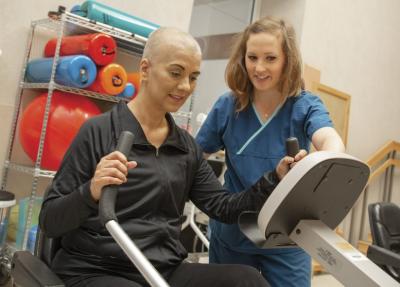Inpatient Rehabilitation and Therapy

Learning to recover from medical conditions
 It is hard to imagine not being able to complete the tasks of everyday life. Still, for those recovering from an illness, injury or surgery, the process of daily living often has to be re-learned through extensive therapy and treatment.
It is hard to imagine not being able to complete the tasks of everyday life. Still, for those recovering from an illness, injury or surgery, the process of daily living often has to be re-learned through extensive therapy and treatment.
“We care for patients with neurological conditions such as stroke and brain injury. It is very common to help people recover from traumatic events such as a fall-with-fracture, a motor vehicle accident that requires surgery, or lengthy hospital stays following cardiac surgery, or illness,” said Andrew D’Avy, P.T., DPT, CNDT, director of rehabilitation, CHRISTUS Inpatient Rehabilitation Center.
D’Avy cares for patients who typically require daily treatment for acute conditions beyond their control. In each case, therapy is key in getting the patient back home living life safely at a maximal level of independence. CHRISTUS Inpatient Rehabilitation Center offers specialized programs and the expertise of a multidisciplinary team providing around-theclock care for recovering patients.
D’avy attributes patient outcomes to several factors, including facility size, personalized care plans, patient motivation and patient support systems. The center provides care for patients from Northwest Louisiana and East Texas. Unlike many oversized, inconvenient setups, the 16-unit facility gives patients one-on-one therapy and genuinely personalized care with a team of specialty-trained physical, occupational and speech therapists; rehabilitation nurses and patient care techs; physicians including physiatry and internal medicine; and dietary and case management teams.
Typically, diagnoses for patients include but are not limited to stroke, brain injury, neurological condition, spinal cord injury, amputation, major multiple trauma, medically complex and patients that need 24-hour supervision. As part of a treatment plan, a physician and therapist decide when inpatient therapy is beneficial for the patient. A majority of therapy in inpatient rehabilitation happens in the Activities of Daily Living (ADL) area. The ADL area is equipped with cooking and laundry facilities, where therapists work with patients having to re-learn to load the washing machine, add detergent and transfer clothing to a dryer or open a box of rice, turn on the stove-top burner and stir the pot while preparing a meal, tasks that seem simple until you or your loved one is recovering from a medical situation or diagnosis that makes it difficult to do. Training on daily personal activities such as bathing or moving on and off the toilet easily are also vital and incorporates selfcare guidance for returning home.
“Often times home evaluations are performed with patients in order to make sure we are teaching them to adapt to their own environment. We also train caregivers to give proper assistance to the patient to make sure returning home is a success story,” said D’Avy.
The patient support system is such an important part of recovery during the transition from hospital to home. This transition is an adjustment for the patient and the caregiver who has to learn how to provide support in different situations, including helping the patient transfer from a wheelchair to a vehicle or a recliner, to the toilet or bed. Sometimes patients need assistance with just about everything, and making sure the caregiver is confident in the task at hand is part of the rehabilitation.
Success in therapy depends on the patient; it takes motivation and a cando attitude to get past having to re-learn simple, daily activities and even walking. Inpatient rehabilitation programs are designed to improve the quality of life for patients by combining treatment and education and providing a unique, patient-centered program of care for fast and effective recovery.
“Our patients must be able to tolerate at least three hours of physical, occupational and speech therapy as needed. Success in therapy starts with the self-motivated patient who desires to return home and get back to the life they love living,” said D’Avy.
Healing offered through inpatient rehabilitation stretches beyond medical and rehabilitative needs, but also a patient’s social, emotional and lifestyle needs.
“Giving patients the opportunity to return home, to go back to work, and to take part in activities they enjoy doing is so rewarding; when our patients succeed, we do, too.”
If you or a loved one has questions about inpatient rehabilitation, have a conversation with a physician and ask about next steps to get back to the life you love.
